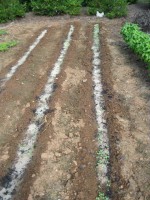 There is nothing quite like the taste of vegetables fresh from the garden and having your own garden is not difficult. The first step is to select a suitable site. The average family of four can feast off a garden of about 625 square feet. The shape of the garden could be a square (25’ on each side), rectangle, or any other shape. If you don’t have a space big enough for to accommodate the size you want, no problem, have several small gardens. The size and shape is not important. The light, water, and soil are the factors that matter.
There is nothing quite like the taste of vegetables fresh from the garden and having your own garden is not difficult. The first step is to select a suitable site. The average family of four can feast off a garden of about 625 square feet. The shape of the garden could be a square (25’ on each side), rectangle, or any other shape. If you don’t have a space big enough for to accommodate the size you want, no problem, have several small gardens. The size and shape is not important. The light, water, and soil are the factors that matter.
Here are the factors to consider when choosing a site for a vegetable garden.
 Light:
Light:
Most vegetables need at least six hours of direct sunlight. Eight to 10 hours is better. Buildings and plants can create shadows so locate the vegetable garden away from them or on the south side of them.
 Slope:
Slope:
A couple of degrees of slope to the south or west allows the sun to hit the soil and plants more directly and warms it so that planting can begin earlier in the year. Three degrees slope is ideal. Too much slope can cause erosion problems and more than a 10% slope can necessitate terracing.
 Air Drainage:
Air Drainage:
Cold air sinks while warm air rises. The areas at the bottom of a hill are colder than areas higher up and will take longer to warm up in spring. They will also be the areas that first experience frost so your growing season in low areas is shorter than higher up.
 Water:
Water:
Most vegetables will not grow in wet soil so avoid areas that are slow to drain after a rain storm. Areas with a slope tend to drain more quickly than low lying or flat areas; sandy soils drain faster than clay soils. On the other hand, vegetables need about 1”/week of water and may have to be watered during times of drought so locating the garden near a water source is a good idea.
 Soil Texture:
Soil Texture:
Like most other plants vegetables thrive in a sandy loam. Of course most of us have considerably less desirable soil and have to amend it. Whether you have clay or sand you can greatly improve it by adding organic matter such as compost, well rooted manure, decayed leaves, old hay or similar materials. Adding organic matter not only improves the texture but all the water holding capacity of the soil and adds nutrients as well.
 Soil Nutrients and pH:
Soil Nutrients and pH:
Vegetables need nitrogen, potassium, phosphorous and about 13 other elements in order to grow well and produce good crops. Some elements have to be added but most are in the soil. The only way you are going to know what you have and what you have to add is to get a soil test. Call your local county extension agent for help; many states provide free or low cost soil testing. Spring is a busy time for soil testers so if possible have the soil test done in fall or winter. The results of the test will tell you not only what elements are present and lacking but also how to correct any problems.
A soil test will also tell you about the pH, that is the acidity/alkalinity of your soil. It will also tell you how to control the pH and make it suitable for a vegetable garden.
 Soil Depth:
Soil Depth:
Shallow soils hinder root development and dry out more quickly than deep soils so avoid locating the vegetable garden on a rocky ledge or over an underground structure.
One way to find the best site for a vegetable garden is to see where other plants are doing well. Where does the lawn thrive? Do you have a lush patch of weeds somewhere? These are probably good places to consider. And yes, you can fudge a little on some factors. For example, lettuce, radishes, broccoli, carrots, and cabbage need less sun that tomatoes and peppers. Then too, the plants may not produce bumper crops but still give you enough to make the garden worthwhile. Hey, one great tomato is better than none! One final thought: a well tended garden is more satisfying and productive than a neglected, untidy one.

[…] you have selected a site for you vegetable garden you should decide what vegetables you want to grow. Sounds easy? It is more difficult than you […]
[…] Before you start with the plan, your need to select the best site for the garden. See my post on How to select a site for a vegetable garden […]